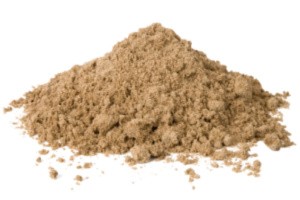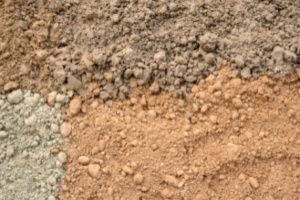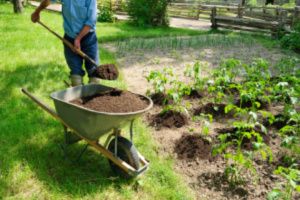Understanding the different types of available soils is one of the keys to successful gardening. Although soil science is broad and complex, it is easy enough for most home gardeners to have a basic grasp of the type of soil in their area and the differences between the main soils used to support gardens.
Two of the most common types of soil you will encounter in home gardening are loam and topsoil. Most planting instructions recommend using loam soil, but the similarity of topsoil naturally leads many people to conclude that they are the same thing. However, there are some important differences to keep in mind when purchasing soil.
What Is Loam?
The term “loam” is used to describe the composition of soil. Loam soil is made from a fairly, equal mix of three types of soil: sandy soil, clay soil and silt. Here is a closer look at each one.
Sandy Soil

Sandy soil is one of the most widely used construction materials. It is made up of particles of hard minerals, such as silicon dioxide and rock. Sand is known for its large soil particles that are visible to the naked eye. These large particles give it excellent aeration and drainage properties.
When sand is dry, it is coarse and runs loosely between your fingers. When it is damp, it cannot be formed into a ball by hand, but instead crumbles away. Although sandy soil doesn’t absorb water well, it boast lots of space for oxygen.
Clay Soil
Of all the soil types, particles of clay are the finest – measuring less than .002 millimeters. Clay soil is made up of microscopic and submicroscopic particles that come from the chemical decomposition process of rocks. As a fine-grained cohesive soil, clay sticks together easily and can form a sticky texture whether it is wet or dry.
Clay expands when it comes into contact with water and shrinks when it is dry, and it is capable of holding a significant amount of water. While sand particles tend to be round, clay particles are flat and thin. Due to organic clay is strong and highly compressible, it is often used as mud mortar in construction.
Silt
Silt is a sediment material whose particle size sits between that of sand and clay. Because it is so fine, it is considered a low plasticity material. When it is wet, it forms smooth mud that can be easily shaped into balls by hand. Wet silt soil incorporated with water will seamlessly form runny mud puddles.

As a mixture of these three types of soil, loam benefits from a variety of positive attributes, such as favorable air circulation, high fertility, and excellent drainage and water retention.
The different characteristics of the components of loam make it easy to determine whether your soil meets the definition of loamy soil. Simply take your soil and fill a Mason jar up to the halfway point with it, and then add water until it is 75 percent full. Place the lid on the jar and shake it thoroughly until all of the soil is floating around. Ensure that no soil remains stuck to the bottom or sides of the jar.
Then, place it somewhere and leave it undisturbed for a few hours or overnight. This will allow the soil to settle and form distinct layers. The bottom layer in the jar will be sand, while the middle layer will be silt and the top layer will be clay. If these three layers are roughly equal in size, it means that you are working with loamy soil.
What Is Topsoil?
The term “topsoil” refers to the uppermost layer of soil, where plants obtain nutrients and sunlight to help the growing process and absorb water. This is also the layer where microorganisms interact with plants, which can run as much as 12 inches deep. It is typically darker in color than the soil under it thanks to the buildup of organic matter it contains, as a result of the decomposition of vegetation on the surface over time.
Like loam, topsoil can be made up of a variety of elements, including clay, sand and silt. The reason many people confuse topsoil and loam is that the ideal type of topsoil for most gardens is some type of loam. This means the term “loamy” can be used to describe some types of topsoil, but it is also possible to find sandy or clay topsoil. The best way to keep this straight is to remember that the term “topsoil” describes the location of the soil, while the term “loam” refers to a soil’s quality.
Applying Topsoil

There are several ways topsoil can be acquired. Many people choose to buy it in bulk from soil suppliers for a more economical way of obtaining high-quality topsoil. It can also be purchased from garden centers in bags of 20 to 40 pounds, although this is only recommended when smaller amounts of soil are needed.
Topsoil can be applied to a garden at any time, but it is ideal to add it during the spring months prior to planting. Another good time to add topsoil is in fall, when it can be used as a top dressing to allow nutrients to break down into soil.
Topsoil can also be amended prior to adding it. Mixing in amendments such as manure, compost, peat moss and other organic matter can improve its qualities and help it reach the ideal composition to foster plant growth. It is useful to lightly spray the surface of topsoil with water after spreading it to fix it into place.
Discuss Your Project With the Soil Professionals
Dirt Connections has a range of high-quality loam, topsoil and other types of dirt that can fill the needs of garden projects of all types and sizes. Reach out today to learn more about our soil offerings and our affordable dirt delivery services in Northern Virginia.
Summary

Dirt Connections was started with one goal in mind: providing quality residential and commercial construction services to clients on time and on budget. Reach out for more information on how we can support your next project.
For your convenience our estimates are free and by appointment. Call 703-940-9949 for a free estimate today!










































